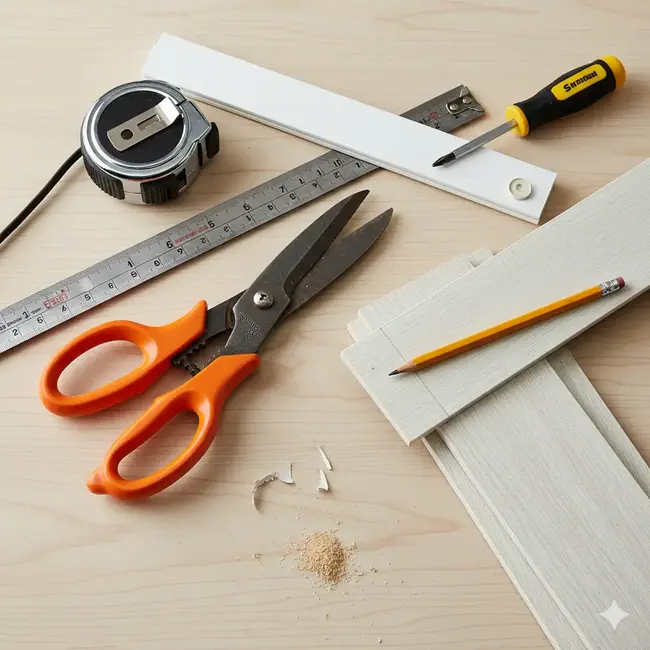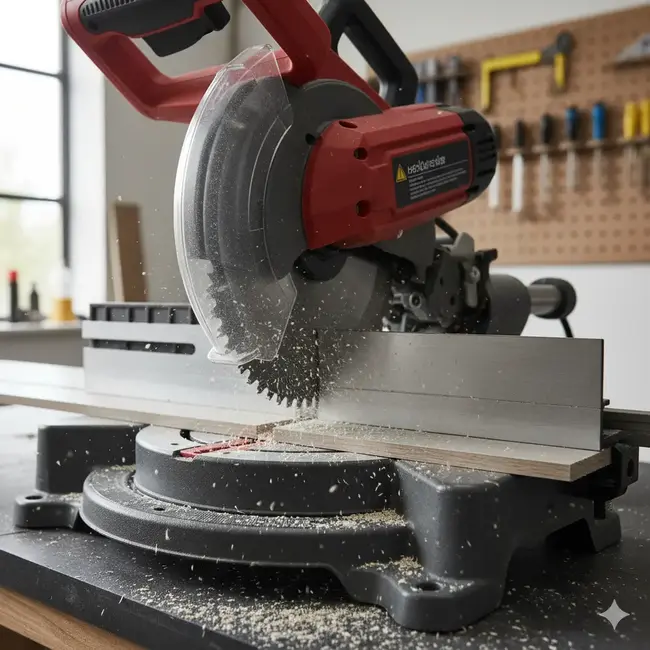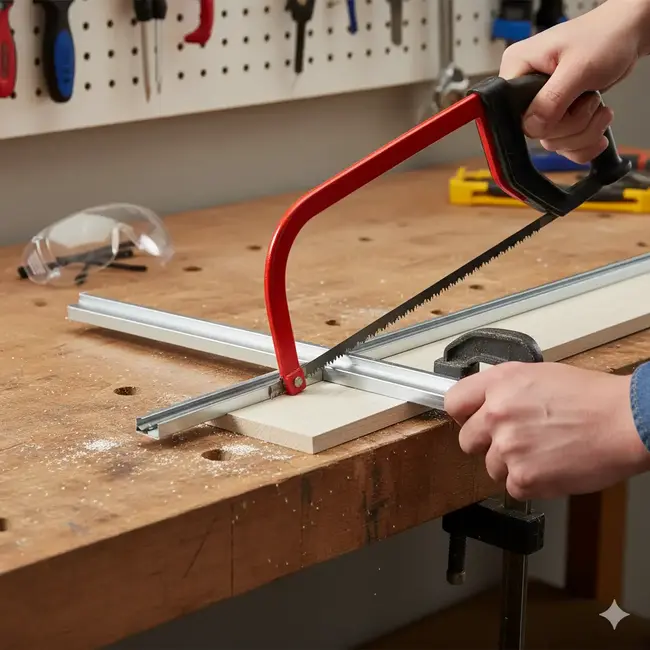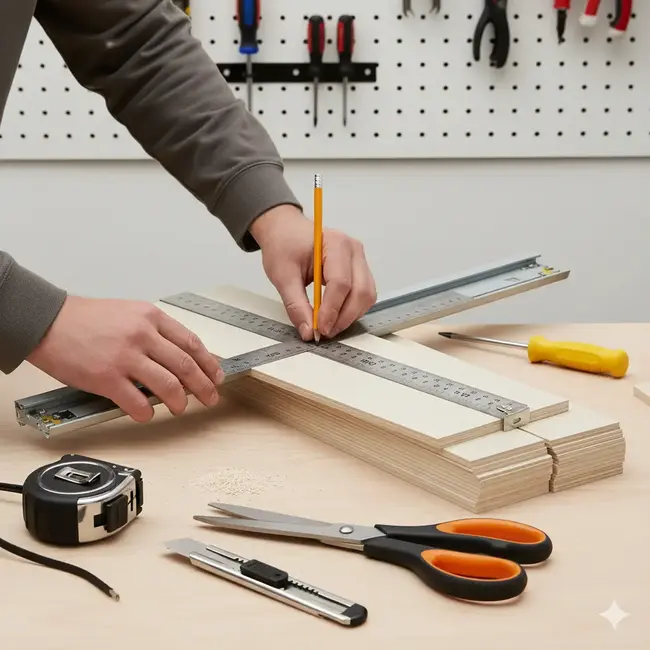Are your overwide faux wood blinds causing improper fit, sagging, and difficult, noisy operation? And you are unsure how to cut faux wood blinds that are too wide to the accurate width without cracking, chipping, overshortening or spoiling your window coverings altogether? Don’t worry – read on to explore various tools and procedures to trim the width of your blinds to the 1/8th of an inch yourself and in minutes!
Read on to learn about various tools and steps recommended by our licensed installation professionals, Juanita and Eric who have 13 years & 11 years of experience, respectively, in the industry.
When You Need to Cut Widthwise Oversized Faux Wood Blinds
Remember, oversized faux wood blinds will look and work perfectly well on exterior or outside mounts. The problem comes only when you need to mount them inside the recess of the window, where even 1/8th of an inch would cause friction, preventing smooth operation & letting light seep through the misaligned, curved slats. The only best solution is removing the extra inches equally from both ends of the slats.
Tools You’ll Need to Cut Extra Width of Faux Wood Blinds

- Screwdriver – to remove pesky end caps on the headrail
- Lead pencil – for marking lines where you’ll cut the slats (never use a fountain pen, as it bleeds through)
- Steel tape measure – for high accuracy in recording values
- Edge or ruler – to draw straight lines/markings on slats
- Sharp cutting tool (the most important one) – to cut the material per the marked lines
6 Quick Tips for a High Precision Cut
- Unhang and level the blinds on a level surface
- Accurately measure, mark, and level the slats before cutting
- Make sharp, 90-degree cuts
- Always use a sharp edged or toothed cutting tool
- Start slower to ensure smooth edges and prevent cracking of the material at the initial point of contact
- Remember, when cutting, the saw blade will take a teeny bit of the slat extra, resulting in a shortened width. So, make sure to line up the blade outside of the marked line.
4. Don’ts of Shortening Extra-wide Faux Wood Blinds
- Don’t use a dull tool – always go for a freshly sharpened one.
- Never go for powered tools, if you are not skilled at using them.
- Don’t use a saw on the blinds which are still on the window.
- Pause the saw, if sawdust collects on the slat, making the cutline invisible.
7 Cutting Tools & Methods to Cut Extrawide Faux Wood Blinds
1. Chop Saw – a High-Precision Tool for Cutting Faux Wood Slats

A new or sharpened chop saw is highly specialized for straight, 90-degree cuts.
Procedure
- Step 1: Set up the saw and the slat correctly on a flat, even surface.
- Step 2: Make the cut smoothly. That’s all!
Pros
- Exceptional precision and efficiency
- Robust construction – ideal for heavy-duty, high-volume cuts in the perfectly straight line
- Superior accuracy and stability
Cons
- Produces sparks, burrs, and dust when cutting the material
- Slow cutting speed which further reduces as the disc wears
Caution
- Always use safety gear, such as gloves and glasses, when using a power tool.
- If you are not a professional, always hire a professional installer for tasks involving power tools.
2. Miter Saw – Accurate Crosscuts for Slats in Dozens
Want to save time, energy, and effort while shortening your faux wood blinds widthwise? Miter saw an excellent tool for accurately trimming the extra width of 2 to 4 dozen slats in a single go! Supports different types of blades to cut wood, artificial wood, and non-ferrous metal slats.
Procedure
- Step 1: Mark and measure the slats and wear safety gear.
- Step 2: Put the slats on the miter saw stand, so the pieces won’t fall away as you cut them.
- Step 3: Bring the blade down into the slats on the marked line. Make sure to slower run the blade to ensure a smooth cut.
Pros
- Comes with a laser guide for accurate, precise cuts
- Exceptional versatile – cut in straight, curved, and angled lines
- Can cut faster and easier than a table saw
Cons
- A serious hazard of being pulled into the blade
- If the cutting head is not in firm control by the handle, the saw may come out violently towards you.
- Can only be used for crosscutting of slats
3. Hacksaw – Easily Cut Both Faux Wood & Metal Parts of the Blinds

A hand saw with a thin, tensioned, fine-toothed blade can cut headrail, bottom rails, and slats of vinyl blinds.
Procedure
- Step 1: Select correct, fine-toothed blade for cutting faux wood.
- Step 2: Secure and tension the blade in the frame, with the teeth pointing forward.
- Step 3: Put on safety glasses and cut the faux wood slats with even strokes and slight pressure against the materials. Make sure to keep the blade on the cutline.
Pros
- Optimized for cutting through hard materials, like PVC and metal
- High speed steel teeth for greatly improved cutting
- Can be used to cut irregularly shaped materials
Cons
- The blades are typically quite brittle, involving the risk of breaking if over tensioned
- Wear out rapidly
4. Jigsaw – Perfect for Making Curved Cuts on Slats for Round Cornered Windows
Also known as a scroll saw or a reciprocating saw, a jigsaw can cut irregularly curved slats with its fine steel blade.
Procedure
- Rest the saw on the material.
- Line up the blade with the cutline (marked line) on the slat.
- Turn on the saw and let the blade reach full speed.
- Just guide the saw and let the blade do the work.
Pros
- Can evenly cut thicker, harder, stiffer slats.
- Can be used to make straight cuts, angled cuts, and curves.
- Relatively narrow blade, ensuring more precision and less sawdust.
Cons
- Unsuitable for long lengthwise cuts, required to shorten vertical blinds
- An expensive option – while an already available utility knife won’t cost a penny, buying a jigsaw will cost $100’s.
Precaution
- Do not apply excessive force to push the jigsaw, let the blade do its work.
- Make sure the base lays flat on the slat, to prevent it straying from the cutline.
5. Tin Snips – Enjoy Comfort and Control for Precise Cutting
One of the most popular types of snips, tin snips are defined by their short blades and long handles. Functioning like scissors, they can precisely cut thin materials like 2 to 3mm thick faux wood blinds.
Procedure
- Mark a cutting line.
- Open the handles wide and position the slats in the jaws of tin snips where the two blades meet.
- Grip the tool firmly and apply steady pressure on the handles, while moving the tool along the cutting line.
- Use sandpaper to smoothen the edges.
Pros
- Allows control for high-precision cuts
- Ergonomically designed grips for applying pressure as require
Cons
- They don’t come with a spring loaded mechanism, so all force comes from your grip strength, leading to hand fatigue.
- When cutting, small pieces of faux wood may fly off
6. Utility Knife – Quick, Efficient Chopping of Protruding Slats
A utility knife is an easily available kitchen tool that can be used to cut horizontal ladder cords and 1 to 3mm thick synthetic wood slats, but it’s not that much high precision and can also be more time consuming.
Procedure
- Step 1: Mark a line where the slat needs to be cut apart.
- Step 2: Repeatedly score the material along the marked line using a fresh knife.
- Step 3: Snap the piece along the weakened line.
Practical Advice
Make sure the slats aren’t thicker than ¼”.
Pros
- Ensures a clean cut, without splintering and sawdust storm
- Can score a precise, shallow line in a faux wood slat
Cons
- Slow, less precise, inefficient results
- Risk of injury if knife gets slipped when slicing the slat
- Only works best on thin, fabric-like slats
Safety Tips
- Wear cut-resistant gloves and safety glasses for added protection.
- Always use a knife with a sharp blade and cut the slat away from your body.
7. Sharp Scissors – Shorten Blinds’ Width While They’re Still on the Window

Use a pair of sharp scissors to cut PVC blinds with slats not more than 2mm thick. However, you’ll need to cut slowly to ensure a smooth, even edge and prevent chipping or cracking of the material.
Procedure
- Step 1: Check if the slats are thin enough and your scissors are sharp enough to cut them
- Step 2: Mark a line on both sides of the slat, indicating the material that extends beyond the frame
- Step 3: Start cutting and go on with scissors facing off
- Step 4: Once done, try readjusting the slats inside the recess and raising/lowering your blinds. If all is well, enjoy! Otherwise, repeat the same cutting procedure.
Note: Always measure the width carefully before cutting.
Pros
- Quickest method for trimming the excess width of your faux wood blinds without removing them from the window
- A handy, lightweight tool for clean, precise cut
- Smoothly slice excess material from faux wood blinds
Cons
- Unfit for cutting thick PVC slats
- May produce jagged, uneven, poor quality edges, which will allow light to seep through
FAQs
How do you fix blinds that are too wide?
- Step 1: Measure and mark the extra width of the slats.
- Step 2: Cut the slats at the markings using a powered saw with sharp teeth to ensure smooth, even cut. We recommend a blade that does not have much bite on it. Use a hacksaw instead of a standard carpenter’s saw.
- Step 3: Try realigning the blinds in the window frame. Recut any edges or corners that extend beyond the window width.
How to cut 2 inch faux blinds?
- Step 1: Remove your 2” faux wood blinds from the window headrail and disassemble them, removing bottom rail, lift cords, and ladder cords.
- Step 2: Take a slat and cut it with a saw, making sure you don’t end up over-shortening it.
- Step 3: Repeat this process with the rest of the slats.
- Step 4: Reassemble and blinds and put them up back on the window.
What tool can I use to cut blinds?
- If your blinds are made of fabric or thin PVC slats, use sharp scissors to cut them to size.
- If they are made of wood or thick faux wood slats, use a hacksaw or a miter saw.
- For blinds made of metal slats, such as aluminum, use fine-toothed power saw, hacksaw or tin snips.
Can you cut blinds yourself?
Absolutely! It is technically possible to cut blinds apart and rehang the remains yourself, without the help of any external agency. To make sure the resized blinds fit perfectly on the first try, we strongly recommend following the pre-cutting steps, such as planning, precise measurements, markings, and leveling.
3 Simple Steps to Cut faux wood blinds to width Using a Utility Knife
Step 1: Unmount the blinds and lay them flat on a clean surface, making sure the slats level and nice.
Step 2: Use a straight edge to draw a line, separating the extra material from the right width. Make sure the line is straight and level, without tilting a millimeter.
Step 3: Carefully cut the slats one after another along the marked line using a sharp utility knife. You’ll need to score the faux wood several times until it cuts through.
Need More Help?
Need design consultation or any other help regarding trimming faux wood blinds widthwise that are too wide? We’re ready to assist and invite you to 24/7 live chat. Or contact us at (800) 863-6109, or customerservice@affordableblinds.com for further assistance.

Leave a Reply